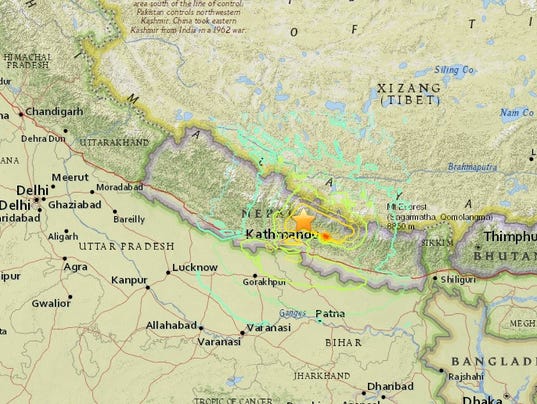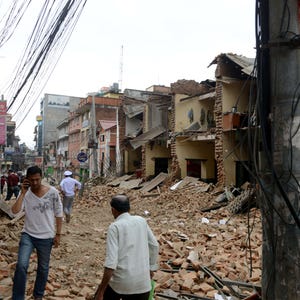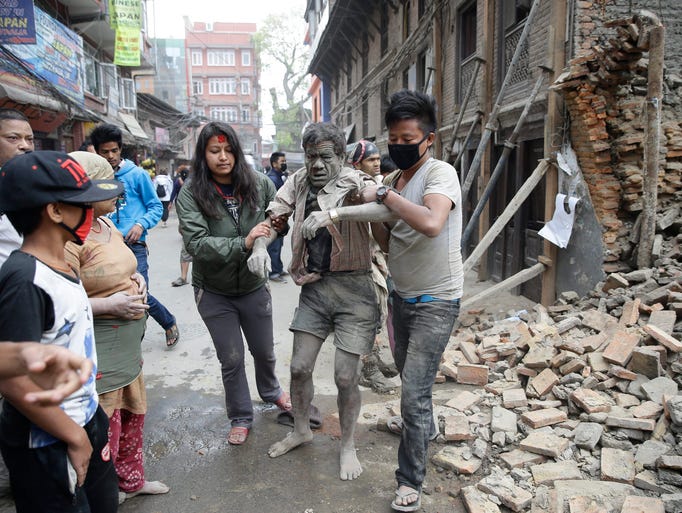Nepal quake occurred at major plate boundary
 Doyle Rice, USA TODAY12:02 p.m. EDT April 25, 2015
Doyle Rice, USA TODAY12:02 p.m. EDT April 25, 2015Saturday's 7.8 magnitude earthquake is the worst to hit Nepal in more than 80 years. Video provided by Newsy Newslook

(Photo: U.S. Geological Survey)
1834CONNECT 122TWEET 3LINKEDIN 2COMMENTEMAILMORE
Saturday's catastrophic earthquake in Nepal occurred because of two converging tectonic plates: the India plate and the overriding Eurasia plate to the north, the U.S. Geological Survey said.
Tectonic plates are the large, thin, relatively rigid plates that move relative to one another on the outer surface of the Earth.
Plates are always slowly moving, but they get stuck at their edges due to friction. When the stress on the edge overcomes the friction, there is an earthquake that releases energy in waves that travel through the Earth's crust and cause the shaking that we feel.

USA TODAY
More than 1,000 dead as 7.8 magnitude quake rocks Nepal
At the location of Saturday's earthquake, about 50 miles to the northeast of the Nepalese capital of Kathmandu, the India plate is converging with Eurasia at a rate of about 2 inches per year toward the north-northeast, driving the uplift of the Himalayan mountain range.

People free a man from the rubble of a destroyed building after an earthquake hit Nepal, in Kathmandu, Nepal, on Saturday, April 25, 2015.A strong magnitude-7.8 earthquake shook Nepal's capital and the densely populated Kathmandu Valley before noon Saturday, collapsing houses, centuries-old temples and cutting open roads in the worst tremor in the Himalayan nation in over 80 years. (Photo: Narendra Shrestha, epa)
Fullscreen



















Next Slide
The quake had a depth of only 7 miles, which is considered shallow in geological terms, the Associated Press reported. The shallower the quake, the more destructive power it carries.
The earthquake was felt as far away as Lahore in Pakistan, which is more than 700 miles away. It was also felt 380 miles away in Lhasa in Tibet, and 400 miles away in Dhaka, Bangladesh.
Although a major plate boundary with a history of large- to great-sized earthquakes, large quakes in this area are rare in the documented historical era, the U.S. Geological Survey reports. Over the past century, just four events of magnitude 6.0 or larger have occurred within about 150 miles of Saturday's earthquake.

USA TODAY
At least 10 dead as Nepal quake rocks Mount Everest
One, a magnitude-6.9 earthquake in August 1988 about 150 miles to the southeast of Saturday's quake, caused nearly 1,500 fatalities, USGS said.
The largest event, a magnitude-8 quake known as the 1934 Nepal-Bihar earthquake, occurred in a similar location to the 1988 quake. It severely damaged Kathmandu, and is thought to have caused around 10,600 deaths.
Only about 15 earthquakes a year in the world — out of 1.3 million total temblors — are magnitude 7 or higher, according to the U.S. Geological Survey. The devastating earthquake and resulting tsunami that hit parts of Japan in 2011, killing thousands of people, was magnitude-9.
Sem comentários:
Enviar um comentário